Multi-Objective Optimization for Analysis of Changing Trade-Offs in the Nepalese Water–Energy–Food Nexus with Hydropower Development
Abstract
:1. Introduction
2. Methods
2.1. The Case of Nepal
2.2. Representation of Water and Power Flows
2.3. Optimization Approach
2.3.1. Decision Variables
2.3.2. Problem Formulation
2.4. Weighting and Constraining Method
3. Results
4. Discussion
Insights for Hydropower Development in the Nepalese Nexus
5. Conclusions
Supplementary Materials
Acknowledgments
Author Contributions
Conflicts of Interest
Appendix A
| Line | Actual Connections | X (Ohms) | Zc (Ohms) | SIL (MW) | Line Limits (MW) |
|---|---|---|---|---|---|
| 1 | Attariya–Kohalpur | 60.80 | 383.25 | 45.46 | 95.57 |
| 2 | Kohalpur–Butwal | 80.23 | 383.25 | 45.46 | 79.56 |
| 3 | Butwal–KGA–Lekhnath | 21.29 | 192.41 | 90.55 | 153.50 |
| 4 | Butwal–Bardghat | 37.38 | 189.07 | 92.16 | 283.26 |
| 5 | Bardghat–Bharatpur | 45.36 | 377.89 | 46.11 | 138.33 |
| 6 | Damauli–Bharatpur | 16.45 | 128.24 | 135.87 | 407.62 |
| 7 | Marsyangdi–Bharatpur | 9.46 | 126.02 | 138.26 | 395.24 |
| 8 | Marsyandi–Siuchatar | 34.69 | 377.89 | 46.11 | 143.94 |
| 9 | Hetauda–KL2–Siuchatar | 17.77 | 773.15 | 90.15 | 270.44 |
| 10 | Hetauda–Dhalkebar | 35.66 | 189.07 | 92.16 | 46.08 |
| 11 | Dhalkebar–Duhabi | 23.24 | 189.07 | 92.16 | 145.55 |
| 12 | Bardghat–Gandak P/S | 25.91 | 186.33 | 93.51 | 280.53 |
References
- Weitz, N.; Huber-Lee, A.; Nilsson, M.; Davis, M.; Hoff, H. Cross-Sectoral Integration in the Sustainable Development Goals: A Nexus Approach; Stockholm Environment Institute: Stockholm, Sweden, 2014. [Google Scholar]
- Hoff, H. Understanding the Nexus. In Background Paper for the Bonn2011 Conference: The Water, Energy and Food Security Nexus; Stockholm Environment Institute: Stockholm, Sweden, 2011. [Google Scholar]
- Bazilian, M.; Rogner, H.; Howells, M.; Hermann, S.; Arent, D.; Gielen, D.; Steduto, P.; Mueller, A.; Komor, P.; Tol, R.S.J.; et al. Considering the energy, water and food nexus: Towards an integrated modelling approach. Energy Policy 2011, 39, 7896–7906. [Google Scholar] [CrossRef]
- Suhardiman, D.; Clement, F.; Bharati, L. Integrated water resources management in Nepal: Key stakeholders’ perceptions and lessons learned. Int. J. Water Resour. Dev. 2015, 31, 284–300. [Google Scholar] [CrossRef]
- Biggs, E.M.; Duncan, J.M.A.; Atkinson, P.M.; Dash, J. Plenty of water, not enough strategy. How inadequate accessibility, poor governance and a volatile government can tip the balance against ensuring water security: The case of Nepal. Environ. Sci. Policy 2013, 33, 388–394. [Google Scholar] [CrossRef]
- Rasul, G. Managing the food, water, and energy nexus for achieving the sustainable development goals in South Asia. Environ. Dev. 2015, 18, 1–12. [Google Scholar] [CrossRef]
- Allouche, J.; Middleton, C.; Gyawali, D. Nexus Nirvana or Nexus Nulity? A Dynamic Approach to Security and Sustainability in the Water-Energy-Food Nexus; STEPS Working Paper 63; STEPS Centre: Brighton, UK, 2014. [Google Scholar]
- Leck, H.; Conway, D.; Bradshaw, M.; Rees, J. Tracing the water-energy-food nexus: Description, theory and practice. Geogr. Compass 2015, 9, 445–460. [Google Scholar] [CrossRef]
- Benson, D.; Gain, A.K.; Rouillard, J.J. Water governance in a comparative perspective: From IWRM to a “nexus” approach? Water Altern. 2015, 8, 756–773. [Google Scholar]
- Gyawali, D. Nexus Governance: Harnessing Contending Forces at Work; International Water Association: London, UK, 2015. [Google Scholar]
- Bizikova, L.; Roy, D.; Swanson, D.; Venema, H.D.; McCandless, M. The Water-Energy-Food Security Nexus: Towards a Practical Planning and Decision-Support Framework for Landscape Investment and Risk Management; International Institute for Sustainable Development: Winnipeg, MB, Canada, 2013. [Google Scholar]
- Flammini, A.; Puri, M.; Pluschke, L.; Dubois, O. Walking the Nexus Talk: Assessing the Water-Energy-Food Nexus in the Context of the Sustainable Energy for All Initiative; Food and Agriculture Organization: Rome, Italy, 2014. [Google Scholar]
- Kumar, N.; Gerber, N. Approaches to Resource Management for the Nexus. Chang. Adapt. Socio-Ecol. Syst. 2015, 2. [Google Scholar] [CrossRef]
- Howells, M.; Hermann, S.; Welsch, M.; Bazilian, M.; Segerström, R.; Alfstad, T.; Gielen, D.; Rogner, H.; Fischer, G.; van Velthuizen, H.; et al. Integrated analysis of climate change, land-use, energy and water strategies. Nat. Clim. Chang. 2013, 3, 621–626. [Google Scholar] [CrossRef]
- Giampietro, M.; Aspinall, R.J.; Bukkens, S.G.F.; Benalcazar, J.C.; Diaz-Maurin, F.; Flammini, A.; Gomiero, T.; Kovacic, Z.; Madrid, C.; Ramos-Martin, J.; et al. An Innovative Accounting Framework for the Food-Energy-Water Nexus: Application of the MuSIASEM Approach to Three Case Studies; Food and Agriculture Organization: Rome, Italy, 2013. [Google Scholar]
- Hurford, A.P.; Harou, J.J. Balancing ecosystem services with energy and food security – Assessing trade-offs from reservoir operation and irrigation investments in Kenya’s Tana Basin. Hydrol. Earth Syst. Sci. 2014, 18, 3259–3277. [Google Scholar] [CrossRef]
- Hurford, A.P.; Huskova, I.; Harou, J.J.; Wallingford, H.R.; Park, H.; Lane, B.; Ox, W. Using many-objective trade-off analysis to help dams promote economic development, protect the poor and enhance ecological health. Environ. Sci. Policy 2013, 38, 72–86. [Google Scholar] [CrossRef]
- Haimes, Y.Y.; Hall, W.A. Sensitivity, responsivity, stability and irreversibility as multiple objectives in civil systems. Adv. Water Resour. 1977, 1, 71–81. [Google Scholar] [CrossRef]
- Cohon, J.L.; Marks, D.H. A review and evaluation of multiobjective programing techniques. Water Resour. Res. 1975, 11, 208–220. [Google Scholar] [CrossRef]
- Loucks, D.P.; van Beek, E.; Stedinger, J.R.; Dijkman, J.P.M.; Villars, M.T. Water Resources Systems Planning and Management: An Introduction to Methods, Models and Applications; The United Nations Educational, Scientific and Cultural Organization: Delft, Netherlands, 2005. [Google Scholar]
- Brown, C.M.; Lund, J.R.; Cai, X.; Reed, P.M.; Zagona, E.A.; Ostfeld, A.; Hall, J.; Characklis, G.W.; Yu, W.; Brekke, L. The future of water resources systems analysis: Toward a scientific framework for sustainable water management. Water Resour. Res. 2015, 51, 6110–6124. [Google Scholar] [CrossRef]
- Maass, A.; Hufschmidt, M.M.; Dorfman, R.; Harold, A.; Thomas, J.; Marglin, S.A.; Fair, G.M. Design of Water-Resource Systems: New Techniques for Relating Economic Objectives, Engineering Analysis, and Governmental Planning; Harvard University Press: Cambridge, MA, USA, 1962. [Google Scholar]
- Cohon, J.L. Multiobjective Programming and Planning; Courier Corporation: North Chelmsford, MA, USA, 1978; Volume 140. [Google Scholar]
- Fleming, P.J.; Purshouse, R.C.; Lygoe, R.J.; Street, M. Many-objective optimization: An engineering design perspective. In Evolutionary Multi-Criterion Optimization; Coello, C.A.C., Aguirre, A.H., Zitzler, E., Eds.; Springer: Berlin/Heidelberg, Germany, 2005; Volume 3410, pp. 14–32. [Google Scholar]
- Coello, C.A.C.; Lamont, G.B.; van Veldhuizen, D.A. Evolutionary Algorithms for Solving Multi-Objective Problems; Springer: Berlin/Heidelberg, Germany, 2007. [Google Scholar]
- Yeh, W.W.-G. Reservoir Management and Operations Models: A State of the Art Review. Water Resour. Res. 1985, 21, 1797–1818. [Google Scholar] [CrossRef]
- Harou, J.J.; Pulido-Velazquez, M.; Rosenberg, D.E.; Medellín-Azuara, J.; Lund, J.R.; Howitt, R.E. Hydro-economic models: Concepts, design, applications, and future prospects. J. Hydrol. 2009, 375, 627–643. [Google Scholar] [CrossRef]
- Labadie, J.W. Optimal operation of multireservoir systems: State-of-the-art review. J. Water Resour. Plan. Manag. 2004, 130, 93–111. [Google Scholar] [CrossRef]
- Maier, H.R.; Kapelan, Z.; Kasprzyk, J.R.; Kollat, J.; Matott, L.S.; Cunha, M.C.; Dandy, G.C.; Gibbs, M.S.; Keedwell, E.; Marchi, A.; et al. Evolutionary algorithms and other metaheuristics in water resources: Current status, research challenges and future directions. Environ. Model. Softw. 2014, 62, 271–299. [Google Scholar] [CrossRef] [Green Version]
- Nicklow, J.; Asce, F.; Reed, P.; Asce, M.; Savic, D.; Dessalegne, T.; Harrell, L.; Chan-Hilton, A.; Karamouz, M.; Minsker, B.; et al. State of the Art for Genetic Algorithms and Beyond in Water Resources Planning and Management. J. Water Resour. Plan. Manag. 2010, 136, 412–432. [Google Scholar] [CrossRef]
- Reed, P.M.; Hadka, D.; Herman, J.D.; Kasprzyk, J.R.; Kollat, J.B. Evolutionary multiobjective optimization in water resources: The past, present, and future. Adv. Water Resour. 2013, 51, 438–456. [Google Scholar] [CrossRef]
- Salazar, J.Z.; Reed, P.M.; Herman, J.D.; Giuliani, M.; Castelletti, A. A diagnostic assessment of evolutionary algorithms for multi-objective surface water reservoir control. Adv. Water Resour. 2016, 92, 172–185. [Google Scholar] [CrossRef]
- Tekiner, H.; Coit, D.W.; Felder, F.A. Multi-period multi-objective electricity generation expansion planning problem with Monte-Carlo simulation. Electr. Power Syst. Res. 2010, 80, 1394–1405. [Google Scholar] [CrossRef]
- Chen, F.; Huang, G.; Fan, Y. A linearization and parameterization approach to tri-objective linear programming problems for power generation expansion planning. Energy 2015, 87, 240–250. [Google Scholar] [CrossRef]
- Aghaei, J.; Akbari, M.A.; Roosta, A.; Baharvandi, A. Multiobjective generation expansion planning considering power system adequacy. Electr. Power Syst. Res. 2013, 102, 8–19. [Google Scholar] [CrossRef]
- Bakirtzis, G.A.; Biskas, P.N.; Chatziathanasiou, V. Generation expansion planning by MILP considering mid-term scheduling decisions. Electr. Power Syst. Res. 2012, 86, 98–112. [Google Scholar] [CrossRef]
- Castelletti, A.; Pianosi, F.; Restelli, M. A multiobjective reinforcement learning approach to water resources systems operation: Pareto frontier approximation in a single run. Water Resour. Res. 2013, 49, 3476–3486. [Google Scholar] [CrossRef]
- World Commission on Dams. Dams and Development: A New Framework for Decision-Making; Earthscan Publications: London, UK, 2000. [Google Scholar]
- Karlberg, L.; Hoff, H.; Amsalu, T.; Andersson, K.; Binnington, T.; Flores-López, F.; de Bruin, A.; Gebrehiwot, S.G.; Gedif, B.; zur Heide, F.; et al. Tackling complexity: Understanding the food-energy-environment nexus in Ethiopia’s lake TANA sub-basin. Water Altern. 2015, 8, 710–734. [Google Scholar]
- Jalilov, S.M.; Keskinen, M.; Varis, O.; Amer, S.; Ward, F.A. Managing the water-energy-food nexus: Gains and losses from new water development in Amu Darya River Basin. J. Hydrol. 2016, 539, 648–661. [Google Scholar] [CrossRef]
- Briscoe, J. The Financing of Hydropower, Irrigation and Water Supply Infrastructure in Developing Countries. Int. J. Water Resour. Dev. 1999, 15, 459–491. [Google Scholar] [CrossRef]
- Richter, B.D.; Postel, S.; Revenga, C.; Scudder, T.; Lehner, B.; Churchill, A.; Chow, M. Lost in development’s shadow: The downstream human consequences of dams. Water Altern. 2010, 3, 14–42. [Google Scholar]
- Biemans, H.; Siderius, C.; Mishra, A.; Ahmad, B. Crop-specific seasonal estimates of irrigation water demand in South Asia. Hydrol. Earth Syst. Sci. Discuss. 2015, 12, 7843–7873. [Google Scholar] [CrossRef]
- Rasul, G. Food, water, and energy security in South Asia: A nexus perspective from the Hindu Kush Himalayan region. Environ. Sci. Policy 2014, 39, 35–48. [Google Scholar] [CrossRef]
- Biemans, H.; Siderius, C.; Mishra, A.; Ahmad, B. Crop-specific seasonal estimates of irrigation-water demand in South Asia. Hydrol. Earth Syst. Sci. 2016, 20, 1971–1982. [Google Scholar] [CrossRef]
- Wood, A.J.; Wollenberg, B.F. Optimal Power Flow. In Power Generation, Operation, and Control; John Wiley & Sons: New York, NY, USA, 1996; Volume 37. [Google Scholar]
- Cheng, W.-C.; Hsu, N.-S.; Cheng, W.-M.; Yeh, W.W.-G. A flow path model for regional water distribution optimization. Water Resour. Res. 2009, 45, 1–12. [Google Scholar] [CrossRef]
- DesInventar Project Team DesInventar—Profile: Nepal. Available online: http://www.desinventar.net/DesInventar/profiletab.jsp?countrycode=npl (accessed on 18 August 2015).
- Ministry of Water Resources. The Hydropower Development Policy, 2001; Singha Durbar: Kathmandu, Nepal, 2001.
- Water and Energy Commission Secretariat. National Water Plan—Nepal; Department of Soil Conservation and Watershed Management: Kathmandu, Nepal, 2005.
- Jarvis, A.; Reuter, H.I.; Nelson, A.; Guevara, E. Hole-filled seamless SRTM data V4. Available online: http://srtm.csi.cgiar.org (accessed on 20 August 2015).
- Department of Electricity Development Issued Licenses. Available online: http://www.doed.gov.np/issued_licenses.php (accessed on 15 September 2015).
- Rijal, N.; Paragon Engineering Consultancy and Research Centre, Lalitpur, Nepal. Personal Communication, 2015.
- Asian Development Bank; International Center for Integrated Mountain Development. Environment Assessment of Nepal Emerging Issues and Challenges; Mountain Forum: Kathmandu, Nepal, 2006. [Google Scholar]
- Dhaubanjar, S. Multiobjective Optimisation for Water Resources Management in Nepal. Master’s Thesis, Department of Environmental Engineering, Technical University of Denmark (DTU), Lyngby, Denmark, 2016. [Google Scholar]
- Nepal Electricity Authority. A Year in Review: Fiscal Year 2014/2015; Nepal Electricity Authority: Kathmandu, Nepal, 2015.
- Shrestha, M.; Load Dispatch Center, Nepal Electricity Authority, Kathmandu, Nepal. Personal Communication, 2015.
- Nepal Electricity Authority. Load Forecast Report; Nepal Electricity Authority: Kathmandu, Nepal, 2015.
- Central Bureau of Statistics. Statistical Year Book of Nepal 2013; Central Bureau of Statistics: Kathmandu, Nepal, 2013.
- Agri-Business Promotion and Statistics Division. Statistical Information on Nepalese Agriculture: Time Series Information 1999/2000-2011/2012; Agri-Business Promotion and Statistics Division: Kathmandu, Nepal, 2013.
- Fang, C.; Sharma, R.; Favre, R.; Hollema, S. Food Security Assessment Mission to Nepal; UN Nepal Information Platform: Nepalgunj, Nepal, 2007. [Google Scholar]
- Nepal National Committee of International Committe of Irrigation and Drainage Nepal. Available online: http://www.icid.org/v_nepal.pdf (accessed on 9 July 2015).
- Food and Agriculture Organization of the United Nations. Irrigation Water Requirement and Water Withdrawal by Country; Food and Agriculture Organization of the United Nations: Rome, Italy, 2012. [Google Scholar]
- Water and Energy Commission Secretariat. Water Resources of Nepal in the Context of Climate Change; Water and Energy Commission Secretariat: Kathmandu, Nepal, 2011. [Google Scholar]
- Thapa, G. Govt Introduces Household Solar System Scheme; Kathmandu Post: Kathmandu, Nepal, 2015. [Google Scholar]
- The Himalayan Times. Load Shedding Time Increases upto 14 Hrs a Day; The Himalayan Times: Kathmandu, Nepal, 2016. [Google Scholar]
- Ministry of Energy. 20-Year Hydropower Development Task Force Report; Ministry of Energy: Kathmandu, Nepal, 2009. (In Nepali)
- Sharma, R.H.; Awal, R. Hydropower development in Nepal. Renew. Sustain. Energy Rev. 2013, 21, 684–693. [Google Scholar] [CrossRef]
- Giri, S. Govt Estimates 200 MW Can Be Added to Grid This Year; Kathmandu Post: Kathmandu, Nepal, 2015. [Google Scholar]
- Japan International Cooperation Agency; Nepal Electricity Authority. Nationwide Master Plan Study on Storage-Type Hydroelectric Power Development in Nepal: Strategic Environmental Impact Assessment Report; Nepal Electricity Authority: Kathmandu, Nepal, 2014.
- Bajracharya, I. Assessment of Run-of-River Hydropower Potential and Power Supply Planning in Nepal Using Hydro Resources; Technischen Universität Wien: Vienna, Austria, 2015. [Google Scholar]
- Hada, R.P. Kulekhani reservoir: Our operational experience. In Hydropower in the New Millennium, Proceedings of the 4th International Conference Hydropower, Bergen, Norway, 20–22 June 2001; Honningsvag, B., Midttomme, G.H., Repp, K., Vaskinn, K., Westeren, T., Eds.; CRC Press: Bergen, Norway, 2001; pp. 75–84. [Google Scholar]
- Tanahu Hydropower Limited Salient Features: Tanahu Hydropower Project. Available online: http://thl.com.np/index.php?nav=salient (accessed on 17 January 2016).
- Nalsing Gad Hydropower Development Committee Salient Features: Nalsing Gad Hydropower Project. Available online: http://www.nhpdc.gov.np/salient-features.php (accessed on 17 August 2015).
- CWE Investment Corp. West Seti Hydropower Project in Nepal: Technical Evaluation; CWE Investment Corp: Kathmandu, Nepal, 2013. [Google Scholar]
- Project Development Department. Budhi Gandaki Hydroelectric Project: Review Report; Roject Development Department: Kathmandu, Nepal, 2011.
- Poff, N.L.; Allan, J.D.; Bain, M.B.; Karr, J.R.; Prestegaard, K.L.; Richter, B.D.; Sparks, R.E.; Stromberg, J.C. The natural flow regime: A paradigm for river conservation and restoration. Bioscience 1997, 47, 769–784. [Google Scholar] [CrossRef]
- Tennant, D.L. Instream Flow Regimens for Fish, Wildlife, Recreation and Related Environmental Resources. Fisheries 1976, 1, 6–10. [Google Scholar] [CrossRef]
- Acreman, M.C.; Dunbar, M.J. Defining environmental river flow requirements—A review. Hydrol. Earth Syst. Sci. 2004, 8, 861–876. [Google Scholar] [CrossRef]
- Smakhtin, V.U.; Shilpakar, R.L.; Hughes, D.A. Hydrology-based assessment of environmental flows: An example from Nepal. Hydrol. Sci. J. 2006, 51, 207–222. [Google Scholar] [CrossRef]
- Flow: The Essentials of Environmental Flows; Dyson, M.; Bergkamp, G.; Scanlon, J. (Eds.) International Union for Conservation of Nature and Natural Resources: Gland, Switzerland; Cambridge, UK, 2003; Volume 1.
- Rai, R.K.; Upadhyay, A.; Ojha, C.S.P.; Singh, V.P. Environmental Flows. In The Yamuna River Basin; Springer: Dordrecht, The Netherlands, 2012; Volume 66, pp. 357–406. [Google Scholar]
- Smakhtin, V.U.; Shilpakar, R.L. Planning for Environmental Water Allocations: An Example of Hydrology-Based Assessment in the East Rapti River, Nepal; Research Report 89; International Water Management Institute: Colombo, Sri Lanka, 2005. [Google Scholar]
- Smakhtin, V.U.; Anputhas, M. An Assessment of Environmental Flow Requirements of Indian River Basins; Research Report 107; International Water Management Institure: Colombo, Sri Lanka, 2006. [Google Scholar]
- Shrestha, A.B.; Wake, C.P.; Mayewski, P.A.; Dibb, J.E. Maximum Temperature Trends in the Himalaya and Its Vicinity : An Analysis Based on Temperature Records from Nepal for the Period 1971–94. J. A. Meteorol. Soc. 1999, 12, 2775–2786. [Google Scholar] [CrossRef]
- Shrestha, M.L.; Shrestha, A.B. Recent trends and potential climate change impacts on glacier retreat/lakes in Nepal and potential adaptation. In Global Forum on Sustainable Development: Development and Climate Change; Department of Hydrology and Meterology: Paris, France, 2004. [Google Scholar]
- Shrestha, S.; Khatiwada, M.; Babel, M.S.; Parajuli, K. Impact of Climate Change on River Flow and Hydropower Production in Kulekhani Hydropower Project of Nepal. Environ. Process. 2014, 1, 231–250. [Google Scholar] [CrossRef]
- Nepal Development Research Institute (NDRI); Practical Action Consulting (PAC); Global Adaptation Partnership (GCAP). Adaptation to Climate Change in the Electricity Sector in Nepal: Vulnerability Assessment Report (Draft); Nepal Development Research Institute (NDRI): Kathmandu, Nepal, 2016. [Google Scholar]
- Nepal Electricity Authority. A Year in Review: Fiscal Year 2013/2014; Nepal Electricity Authority: Kathmandu, Nepal, 2014.
- Shrestha, P. Cross-Border Transmission Line between Nepal and India: A Test-Case for the Analysis of HVDC Integration into an Existing HVAC System. Master’s. Thesis, Norwegian University of Science and Technology (NTNU), Trondheim, Norway, 2016. [Google Scholar]
- IBM Corporations ILOG CPLEX Optimization Studio 12.6.1. Available online: https://www.ibm.com/support/knowledgecenter/en/SSSA5P_12.6.1/ilog.odms.studio.help/Optimization_Studio/topics/COS_home.html (accessed on 5 January 2016).
- Seifi, H.; Sepasian, M.S. DC Load Flow. In Electric Power System Planning: Issues, Algorithms and Solutions; Springer Science & Business Media: Berlin/Heidelberg, Germany, 2011; pp. 245–248. [Google Scholar]
- Molzahn, D.K.; Friedman, Z.B.; Lesieutre, B.C.; DeMarco, C.L.; Ferris, M.C. Estimation of Constraint Parameters in Optimal Power Flow Data Sets. In Proceedings of the 2015 North American Power Symposium (NAPS), Charlotte, NC, USA, 4–6 October 2015.
- Ko, S.K.; Fontane, D.G.; Labadie, J.W. Multiobjective optimization of reservoir systems operation. Water Resour. Bull. 1992, 28, 111–127. [Google Scholar] [CrossRef]
- Marler, R.T.; Arora, J.S. The weighted sum method for multi-objective optimization: New insights. Struct. Multidiscip. Optim. 2010, 41, 853–862. [Google Scholar] [CrossRef]
- Kollat, J.B.; Reed, P. A framework for Visually Interactive Decision-making and Design using Evolutionary Multi-objective Optimization (VIDEO). Environ. Model. Softw. 2007, 22, 1691–1704. [Google Scholar] [CrossRef]
- Matrosov, E.S.; Huskova, I.; Kasprzyk, J.R.; Harou, J.J.; Lambert, C.; Reed, P.M. Many-objective optimization and visual analytics reveal key trade-offs for London’s water supply. J. Hydrol. 2015, 531, 1040–1053. [Google Scholar] [CrossRef]
- Kasprzyk, J.R.; Nataraj, S.; Reed, P.M.; Lempert, R.J. Many objective robust decision making for complex environmental systems undergoing change. Environ. Model. Softw. 2013, 42, 55–71. [Google Scholar] [CrossRef]
- Kasprzyk, J.R.; Reed, P.M.; Kirsch, B.R.; Characklis, G.W. Managing population and drought risks using many-objective water portfolio planning under uncertainty. Water Resour. Res. 2009, 45. [Google Scholar] [CrossRef]
- Kasprzyk, J.R.; Reed, P.M.; Characklis, G.W.; Kirsch, B.R. Many-objective de Novo water supply portfolio planning under deep uncertainty. Environ. Model. Softw. 2012, 34, 87–104. [Google Scholar] [CrossRef]
- Giuliani, M.; Herman, J.D.; Castelletti, A.; Reed, P. Many-objective reservoir policy identification and refinement to reduce policy inertia and myopia in water management. Water Resour. Res. 2014, 50, 3355–3377. [Google Scholar] [CrossRef]
- Brill, E.D.; Flach, J.M.; Hopkins, L.D.; Ranjithan, S. MGA: A secision support system for complex, incompletely defined problems. IEEE Trans. Syst. Man Cybern. 1990, 20, 745–757. [Google Scholar] [CrossRef]
- Geressu, R.T.; Harou, J.J. Screening reservoir systems by considering the efficient trade-offs—Informing infrastructure investment decisions on the Blue Nile. Environ. Res. Lett. 2015, 10, 125008. [Google Scholar] [CrossRef]
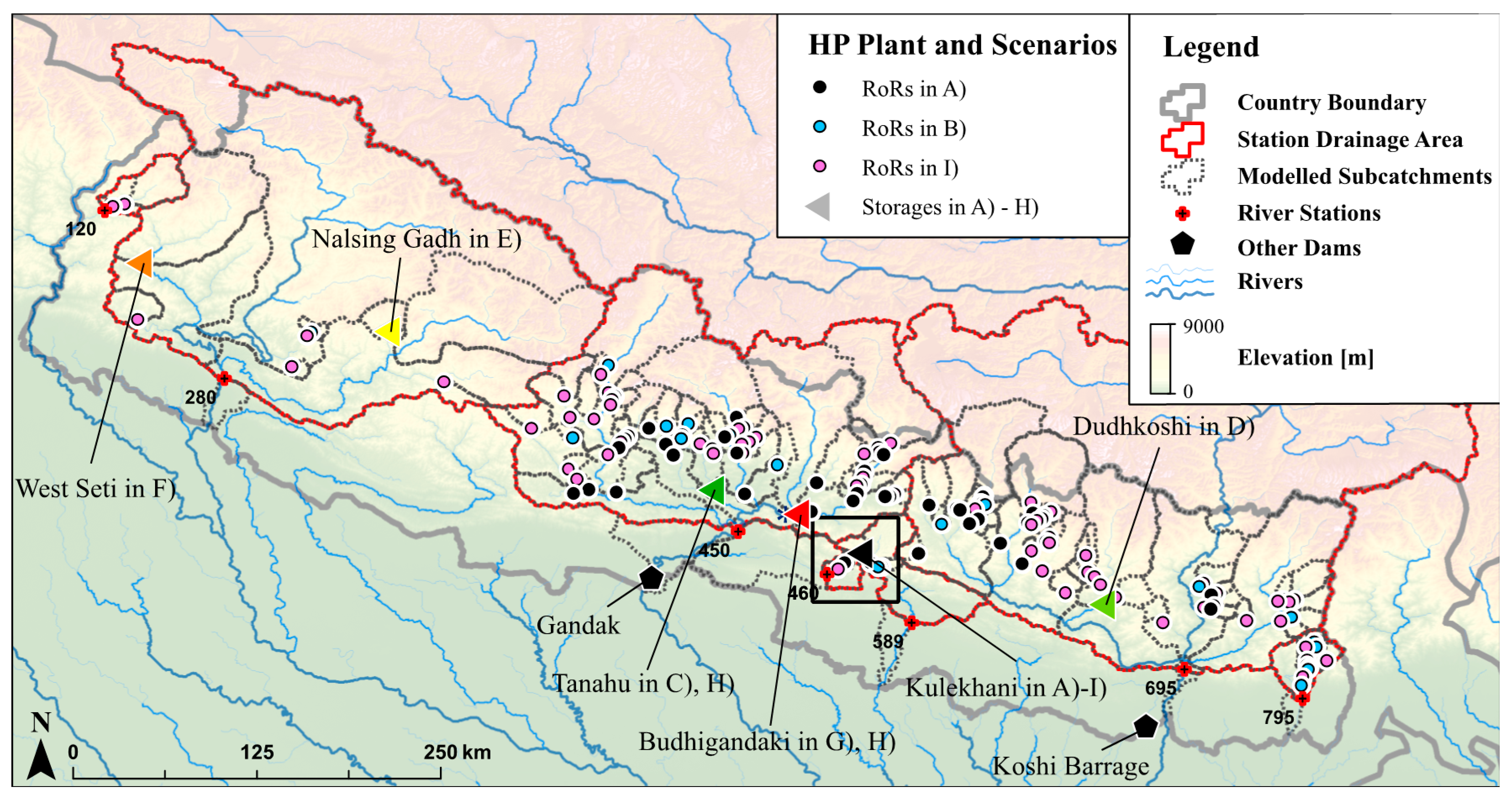
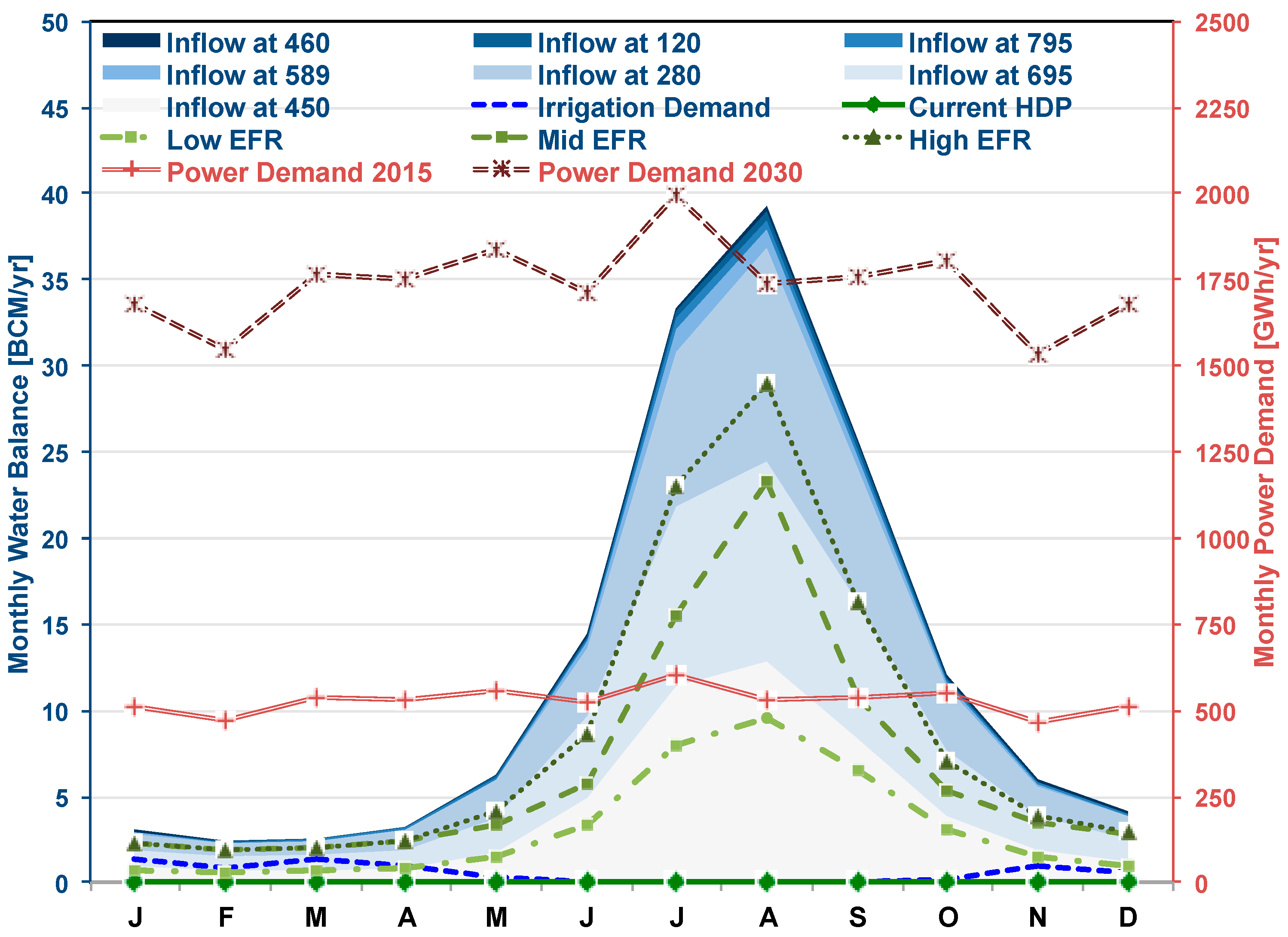
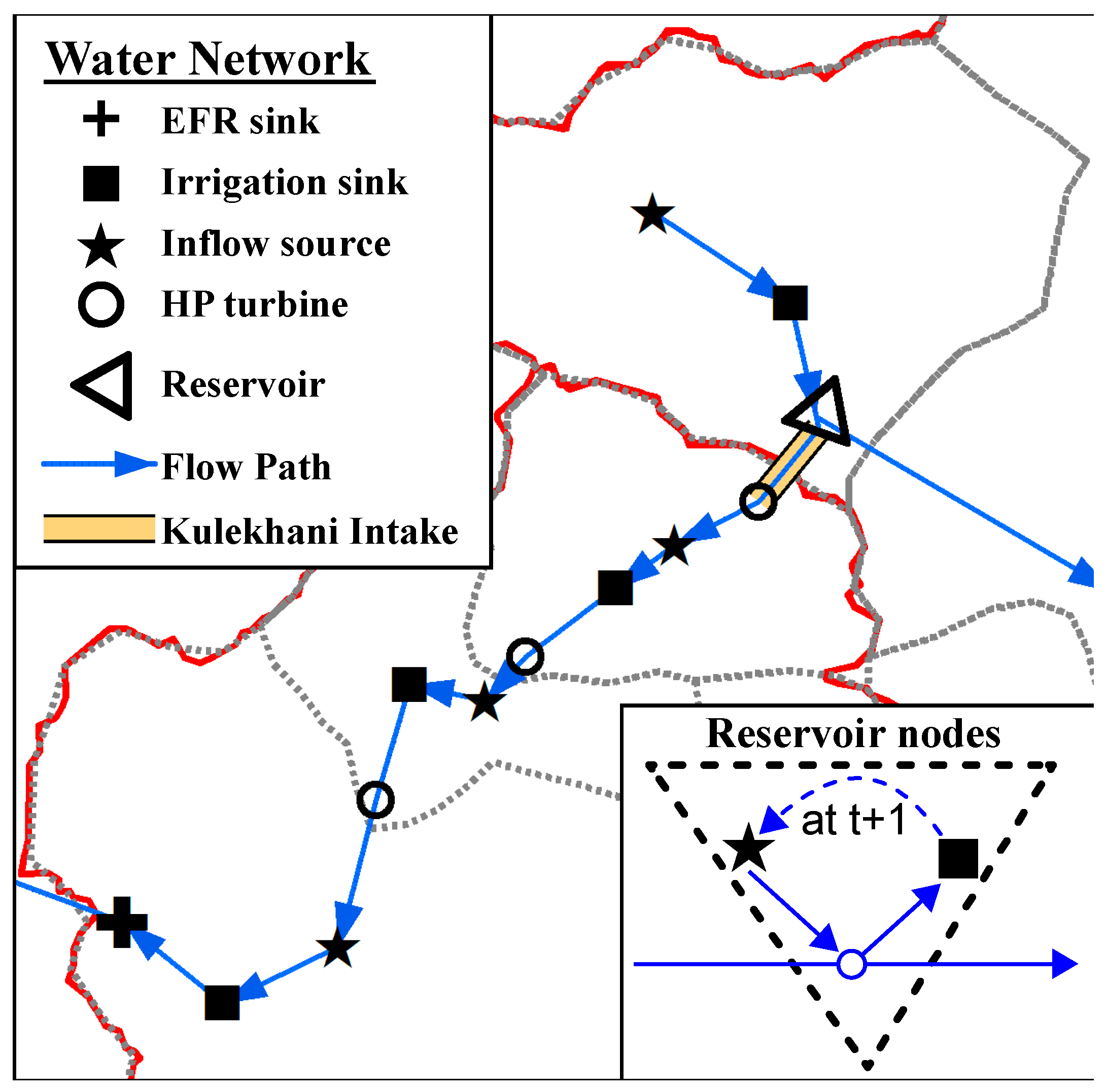

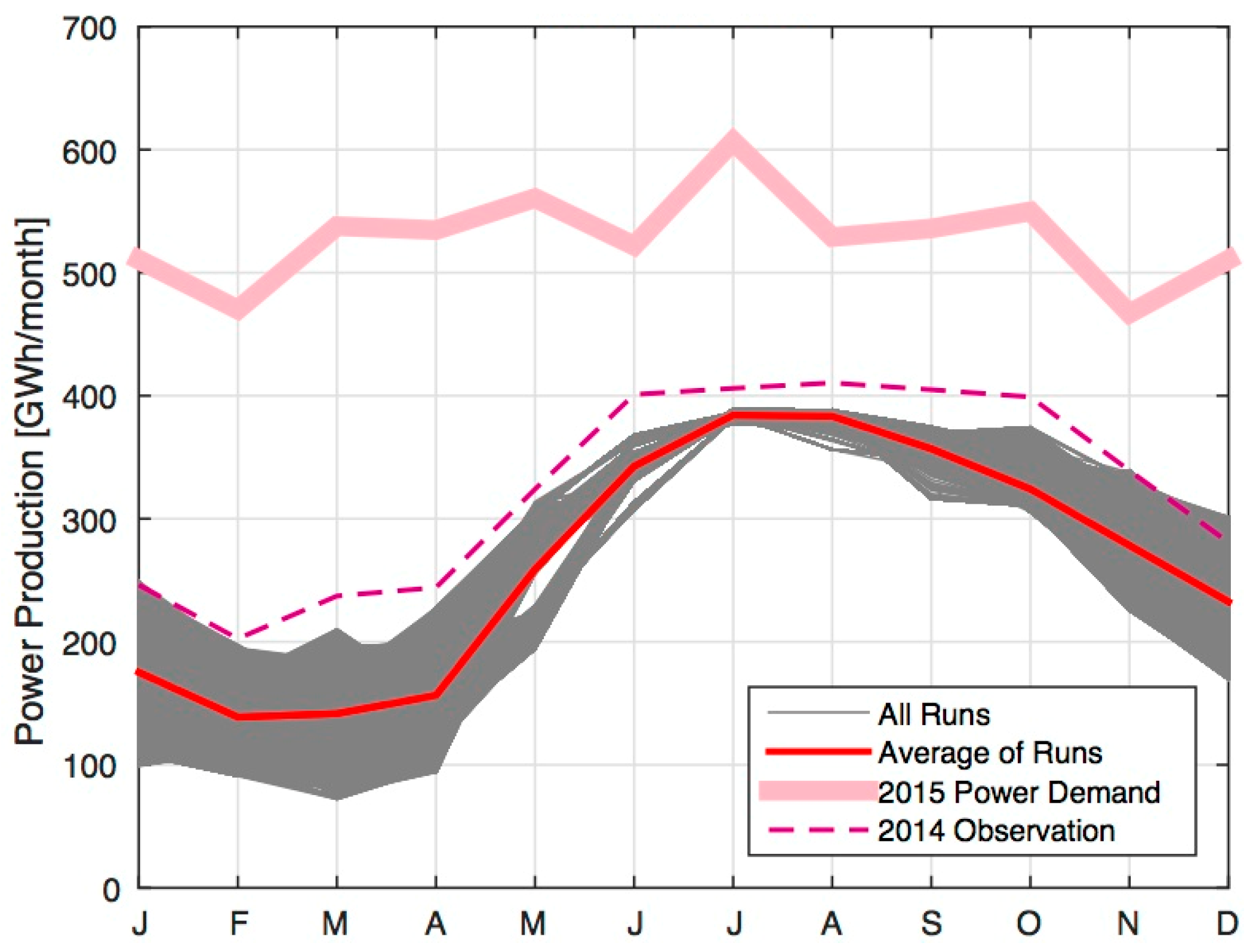



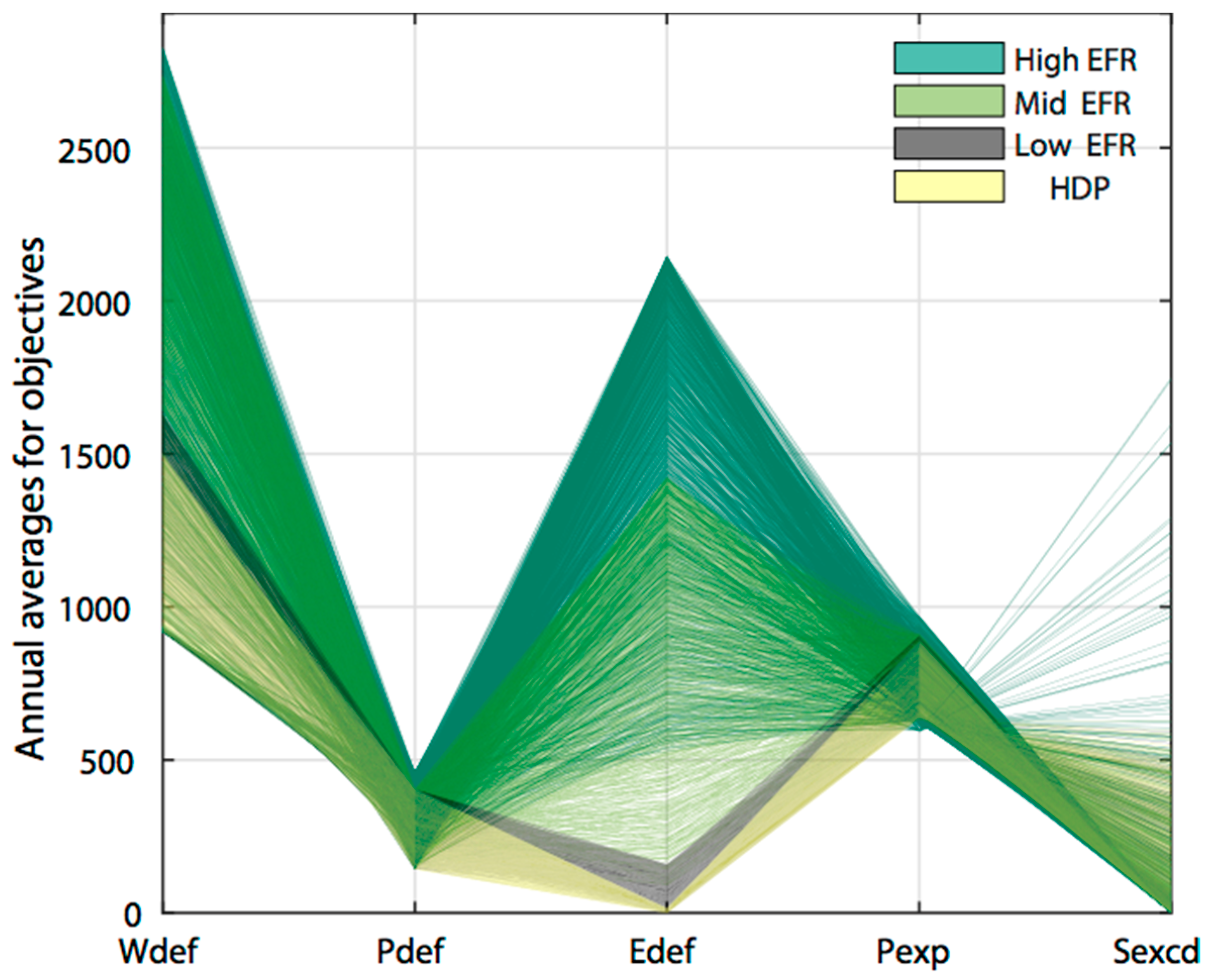
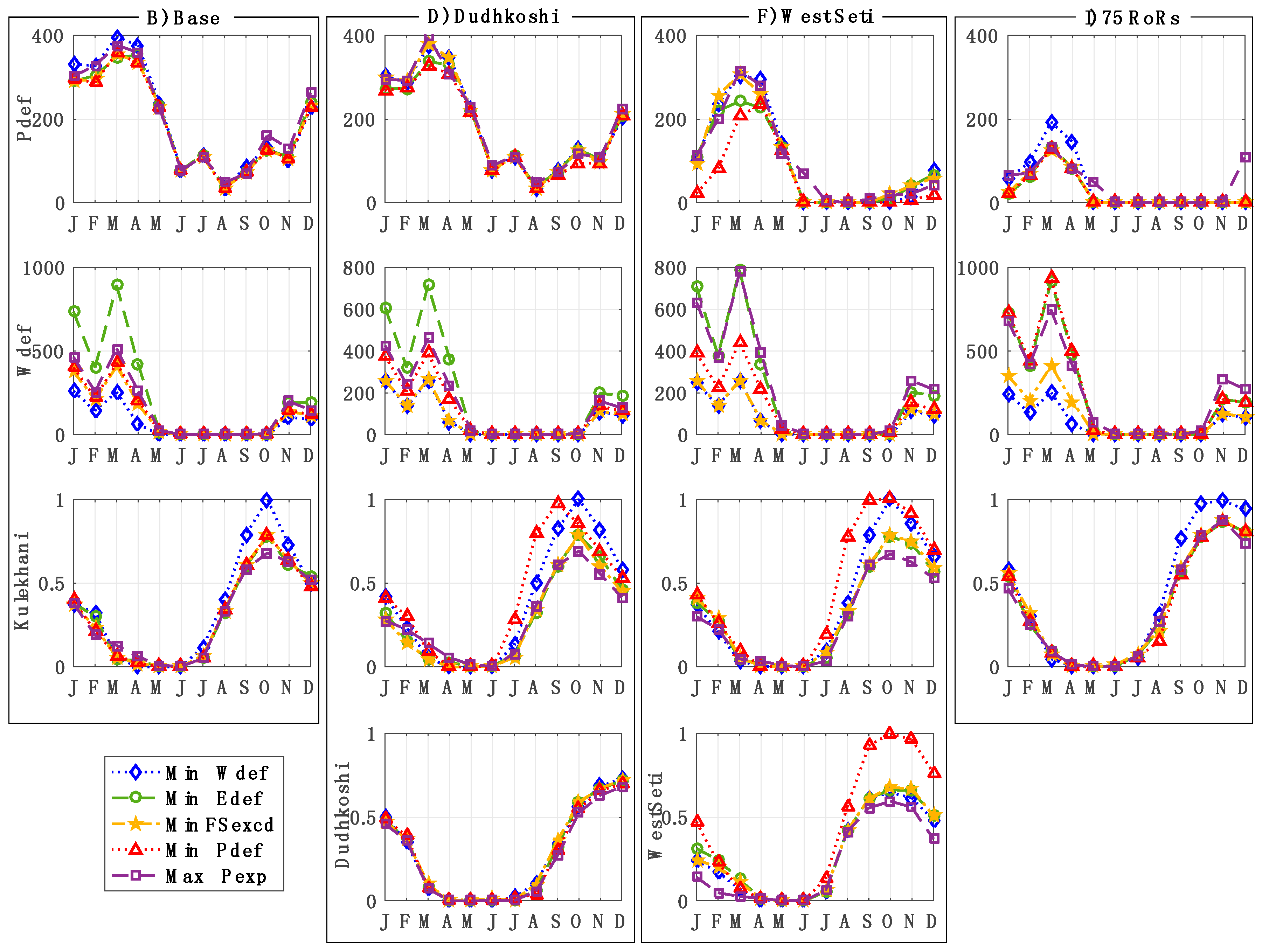
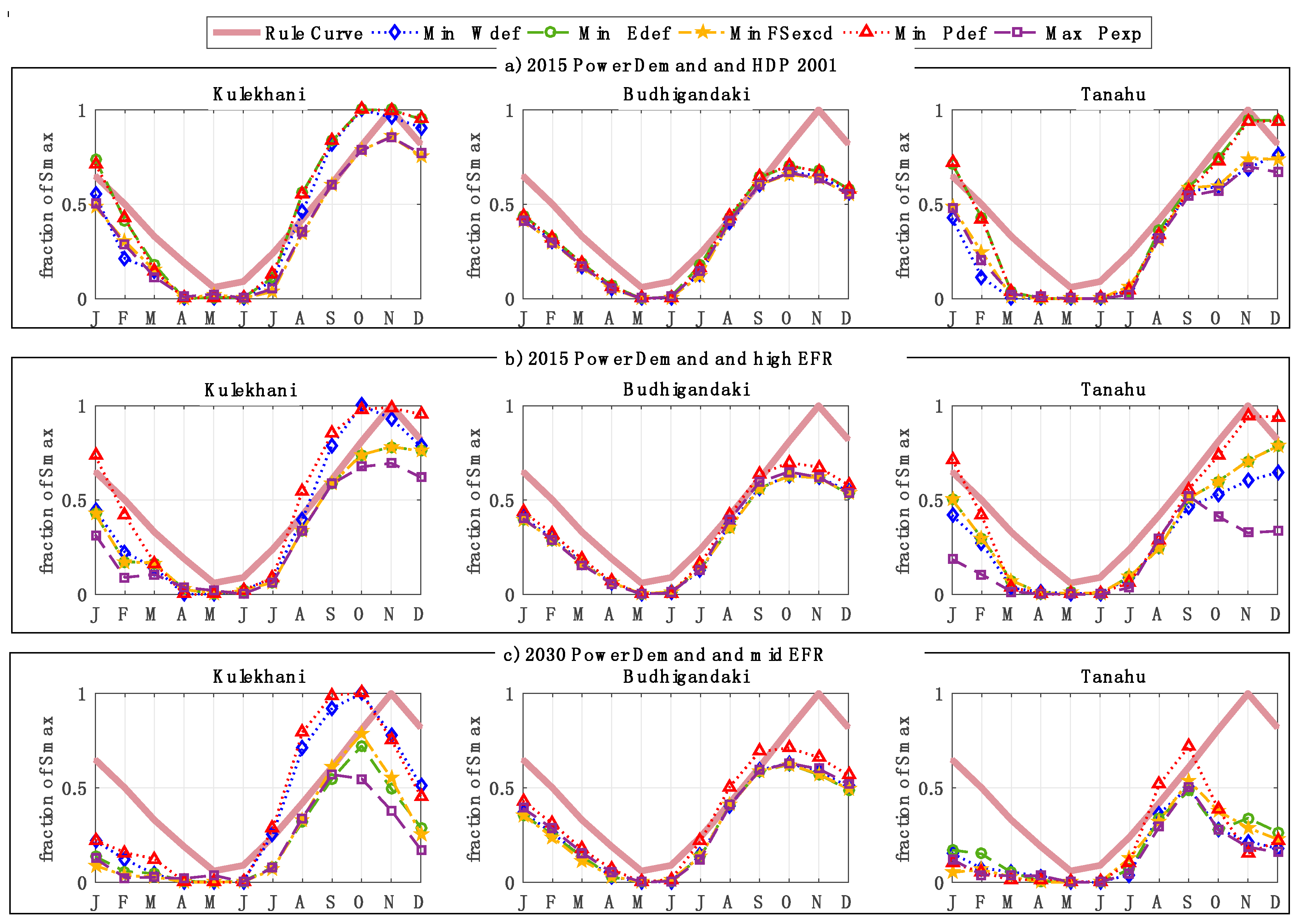
| Parameter | Quantity | Unit | Adapted from | |
|---|---|---|---|---|
| Inflow for 1995–2008 | 152 | 109 m3/year | [53] | |
| Environmental Flow Requirement (EFR) | HDP | 0.673 | 109 m3/year | [55] |
| Low | 37.5 | 109 m3/year | ||
| Mid | 79.1 | 109 m3/year | ||
| High | 104 | 109 m3/year | ||
| Irrigation Demand | 7.03 | 109 m3/year | [45] | |
| Power Demand | 2015 | 6335 | GWh/year | [56,57] |
| 2030 | 20,811.80 | GWh/year | [56,58] | |
| HP Development Scenarios | Added Capacity (MW) | Reservoir Capacity (MCM) | Head (m) | Discharge (m3/s) | Source | |
|---|---|---|---|---|---|---|
| A) | Existing 39 RoRs + Kulekhani * | 692 | 63.3 | 550 | 12.1 | [72] |
| B) | A + 21 RoRs completed in 2016 | 203 | - | multiple | multiple | [69] |
| C) | B + Tanahu | 127 | 295.1 | 112.5 | 127 | [73] |
| D) | B + Dudhkoshi | 300 | 687.4 | 249.3 | 136 | [70] |
| E) | B + Nalsing Gadh | 410 | 419.6 | 635.5 | 75 | [74] |
| F) | B + West Seti | 750 | 1483 | 258 | 327 | [75] |
| G) | B + Budhigandaki | 1200 | 4467 | 200 | 672 | [76] |
| H) | B + Tanahu + Budhigandaki | 1327 | See scenarios C and I | |||
| I) | B + 75 under-construction RoRs | 1964 | - | multiple | multiple | [52] |
© 2017 by the authors. Licensee MDPI, Basel, Switzerland. This article is an open access article distributed under the terms and conditions of the Creative Commons Attribution (CC BY) license ( http://creativecommons.org/licenses/by/4.0/).
Share and Cite
Dhaubanjar, S.; Davidsen, C.; Bauer-Gottwein, P. Multi-Objective Optimization for Analysis of Changing Trade-Offs in the Nepalese Water–Energy–Food Nexus with Hydropower Development. Water 2017, 9, 162. https://doi.org/10.3390/w9030162
Dhaubanjar S, Davidsen C, Bauer-Gottwein P. Multi-Objective Optimization for Analysis of Changing Trade-Offs in the Nepalese Water–Energy–Food Nexus with Hydropower Development. Water. 2017; 9(3):162. https://doi.org/10.3390/w9030162
Chicago/Turabian StyleDhaubanjar, Sanita, Claus Davidsen, and Peter Bauer-Gottwein. 2017. "Multi-Objective Optimization for Analysis of Changing Trade-Offs in the Nepalese Water–Energy–Food Nexus with Hydropower Development" Water 9, no. 3: 162. https://doi.org/10.3390/w9030162






